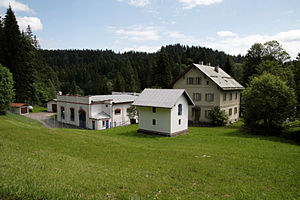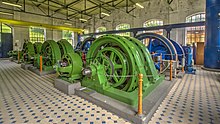Kammerl hydropower plant
| Kammerl hydropower plant | ||
|---|---|---|
| Kammerl hydropower plant | ||
| location | ||
|
|
||
| Coordinates | 47 ° 39 '43 " N , 10 ° 59' 12" E | |
| country |
|
|
| place | Saulgrub | |
| Waters | Bunting | |
| power plant | ||
| owner | DB Energie GmbH | |
| operator | DB Energie GmbH | |
| Start of planning | 1897 (license granted) | |
| construction time | 1897-1899 | |
| Start of operation | 1899 | |
| Shutdown | 2013 | |
| Listed since | Yes | |
| technology | ||
| Bottleneck performance | 0.4 megawatts | |
| Expansion flow | 6.09 m³ / s | |
| Turbines | 3 Francis turbines | |
| Generators | 3 traction current generators (single-phase) | |
| Others | ||
The Kammerl hydropower plant is an old run-of-river power plant for generating traction current on the Ammer near Saulgrub . It was built between 1897 and 1899 to supply the Ammergaubahn , a branch line from Murnau to Oberammergau , which, after initial difficulties, was the first German railway to be operated as planned with single-phase alternating current at low frequency from 1905 .
Until its closure in 2013, the Kammerl hydropower plant was the oldest still operating railway power plant of its type in the world. In addition, as one of only two German traction power plants (the other is Bad Abbach ), it did not feed the electricity generated into the 110 kV traction network, but directly into the overhead line of the Ammergau Railway. This was done via a 15 kV cable to Saulgrub .
In the years 2013 to 2015, a new one with a higher output was built next to the old power plant, which, however, no longer generates traction current.
technical structure
building
The power plant with a comparatively inconspicuous machine hall is located about four kilometers southwest of Saulgrub an der Ammer. The simple building is built in Art Nouveau style and is essentially still in its original state. In the immediate vicinity there is a simple residential building and a few meters next to it is a wash house for the former employees. These houses are not in use today because the power plant is automated and monitored and remotely controlled from the central switchboard in Munich. The power plant is a listed building.
machinery
There are three sets of machines in the hall, each consisting of a Francis turbine , a flywheel with clutch and a traction current generator . The turbines supplied by Voith have a maximum flow rate of 2.03 m³ / s, a speed of 240 / min and a nominal output of 367 kW or 500 hp. The flywheels with a diameter of 3.30 m have a rim mass of 5200 kg. The generators, each with an output of 280 kW, provided single-phase alternating current at 5500 V and 16 Hz. During the conversion in the years 1951–1953, the system was converted to the commonly used traction current of 15 kV and 16 ⅔ Hz. There is also a generator that supplies three-phase alternating current at 400 V and 50 Hz, with excess being fed into the 20 kV line of E.ON Bayern .
Water flow
The power plant is operated with water that is derived from the river Ammer and fed to the power plant via a canal with a tunnel and an aqueduct and finally an underground pressure pipe .
At Altenau, southwest of Saulgrub, the water is directed from the Ammer at a weir with an inlet structure , dirt rake and automatic cleaning system into a 1490 m long canal, which leads to the power plant with a gradient of 0.67 ‰. The canal is 1.50 m wide and 1.52 m deep at the bottom. After only 162 m it disappears in a 184 m long tunnel. This tunnel ends directly on an aqueduct high above the Halbammer. The aqueduct carries an iron, 81.4 m long, 2.50 m wide and roughly the same height box-shaped canal. The aqueduct is accessible, but closed to unauthorized persons. This is followed by a 1063 m long, open canal that runs in an S-shaped arch and ends above the power station. Via a small inlet structure with an automatic dirt rake and fully automatic single-arm cleaning system, the water reaches the turbines in the machine house 18 m below in an underground pressure pipe made of riveted sheet steel with a diameter of 2 m. The pressure pipe is followed by another pipe with a diameter of 1.3 m, which is led upwards in a corner of the machine room for 5.40 m and is closed at the end. The air cushion at its end serves as a pressure vessel to compensate for the pressure fluctuations when the turbines are switched on and off. The turbines are connected via so-called suction pipes to the outlet channel 6 m lower, so that there is a useful gradient of 24 m. The concreted outlet channel leads the water back into the Ammer after around 120 m. Water that is not consumed by the switched-off turbines also flows back into the Ammer behind the small intake structure via a steep concrete channel known as an empty shot.
history
In 1897, the Actiengesellschaft Elektrizitätswerke, formerly OL Kummer & Co., Dresden, based in Munich , received the concession to build and operate a railway line from Murnau to Oberammergau. The 24 km long, single-track line was to be operated electrically, while the surrounding area was to be supplied with electricity. For this purpose, the Kammerl hydropower plant was built around four kilometers west of the middle of the route. It had two Francis turbines with a horizontal shaft and generators to generate three-phase alternating current with 5000 V and 40 Hz. On the line, transformers were to transform the voltage to 800 V. The power station cost around 800,000 gold marks and was completed in 1899. However, the electric train operation failed because of the technical problems that were not yet mastered at the time. The railway was therefore operated with steam locomotives, the power station supplied the surrounding communities.
After the operator went bankrupt , the Munich Local Railway acquired the power station and the railway line in November 1903 at a price of 576,000 gold marks. In the period from March to November 1904, it had the generators from Siemens-Schuckertwerke dismantled and a flywheel installed on each turbine, which via a coupling with a 280 kW 350 kVA traction current generator for the generation of single-phase alternating current with 5500 V and 16 Hz as well as a Another 150 kW 167 kVA three-phase generator for the generation of three-phase alternating current with 5000 V and 40 Hz was connected. The traction current was originally fed directly to Saulgrub station and there into the overhead line of the railway line.
On January 1, 1905, electric train operation with the LAG No. 674 to 677 railcars began. The Ammergau Railway was the first railway in the world that was operated according to schedule with single-phase alternating current at a low frequency. This means that the Kammerl hydropower station was the oldest still operating railway power station of its kind in the world until it was closed .
In 1908 an almost identical set of machines was added, which in turn consisted of a Francis turbine with a flywheel and coupling and a 280 kW traction current generator and a 216 kW three-phase generator. There were also two sets of excitation machines , each consisting of a Francis turbine with an output of 30 HP and direct current generators with an output of 20 kW each. As well as a later retrofitted exciter, which was driven by a three-phase motor.
The power station generated around ⅔ traction current and ⅓ electricity for the public supply, which was supplied to the Isar-Amperwerke from June 1, 1926 .
On June 16, 1938, the power station and the railway line were taken over by the Reichsbahn . The supply of the country was stopped. For this purpose, the slip rings, rotor poles and stator windings were removed from the three-phase generators, but the rotor and the stator were left as they were for the sake of simplicity.
While the Reichsbahn had long been running at 15,000 V 16 Hz, the island operation of the Ammergaubahn, which was supplied with 5500 V 16 Hz by the Kammerl power station , was retained until the renovations between 1951 and 1953, when the power station and the railway switched to the commonly used traction current and one single-phase transformer per machine set and one switchgear were installed. The machine system was also converted to 16 ⅔ Hz.
In the 1980s, the control of the guide vanes of the main turbines was converted to electronic controllers with hydraulic actuators. The system, which was originally controlled by a control panel in the machine hall, was automated and initially monitored and controlled from Murnau. Since 1993, this has been done from the central control room in Munich, which operates the southern German 15 kV overhead line network.
When DB Energie GmbH was founded on January 1, 1997, the plant was transferred to it.
Of the two small turbines, only the smaller one has survived, in which the direct current generator was replaced by a three-phase asynchronous generator in the 1990s, which generates electricity at 50 Hz primarily for its own use, although surpluses are fed into the 20 kV line of the Isar Amperwerke, which today E.ON Bayern were fed.
New building
Between May 2013 and 2015, a new power plant with a nominal output of 1.2 MW was built by DB Energie. The Ammerwehr was also rebuilt. The new power plant uses a Kaplan turbine and a 50 Hz three-phase generator to generate around 7500 MWh of energy per year, which is fed into the Bayernwerke network.
sightseeing
Visits to the power plant, which were previously possible on request, can no longer be offered. However, the power plant is mostly open on the Open Monument Day (2nd Sunday in September).
Web links
- Information on the website of the Garmisch-Partenkirchen citizens' network ( Memento from January 28, 2005 in the Internet Archive )
- Information sheet of the Munich S-Bahn interest group (PDF file; 144 kB)
- Video about the power plant (2011)
- Friends of the historic hydroelectric power station Kammerl eV
Individual evidence
- ^ Ralf Specht: History and technology of the hydroelectric power station Kammerl in: Elektro Bahnen, 99 (2001), 11, pp. 444–452.
- ↑ Monument Viewer
- ↑ a b chief engineer Ehnhart: The AC train Murnau-Oberammergau . In: Wilhelm Kübler (Hrsg.): Electric railways and operations . Issue 20. R. Oldenbourg, July 14, 1905, p. 365 ff .
- ↑ Ralf Roman Rossberg : "Bahnstrom" as an ingenious emergency solution ( Memento from March 27, 2007 in the Internet Archive )
- ↑ 1903 according to Ralf Specht, November 19th , 1900 according to the bronze plaque at the entrance of the power plant
- ↑ Rehabilitation of the Kammerl hydropower plant. In: https://eb-info.eu . Retrieved July 24, 2019 .
- ↑ Bernd Mühlstraßer: New power plant ( Memento from January 15, 2016 in the Internet Archive )
- ↑ Kammerl power plant. In: https://www-docs.b-tu.de . DB Museum, accessed on July 22, 2019 .




